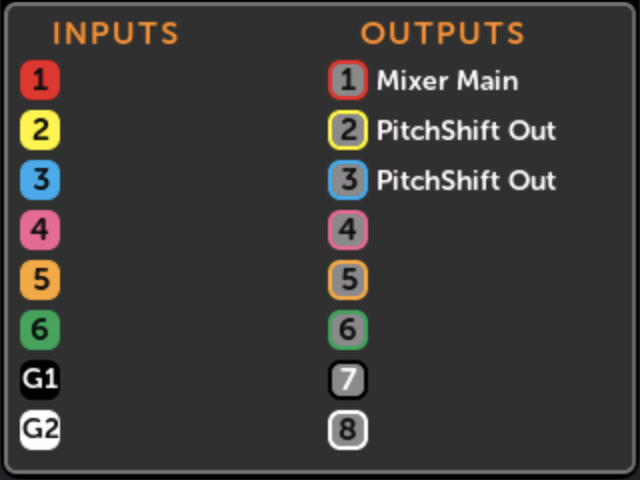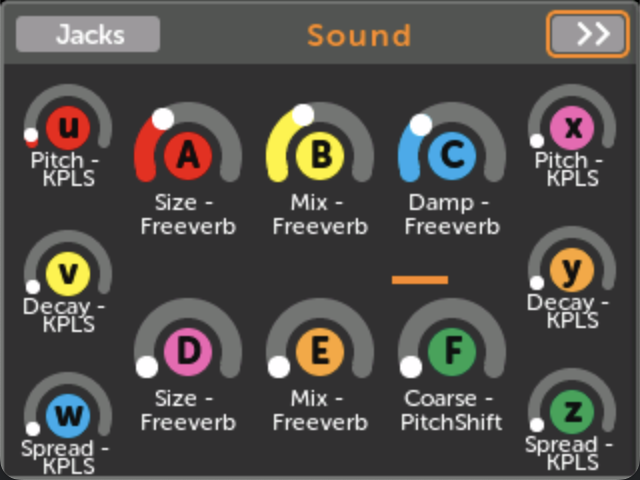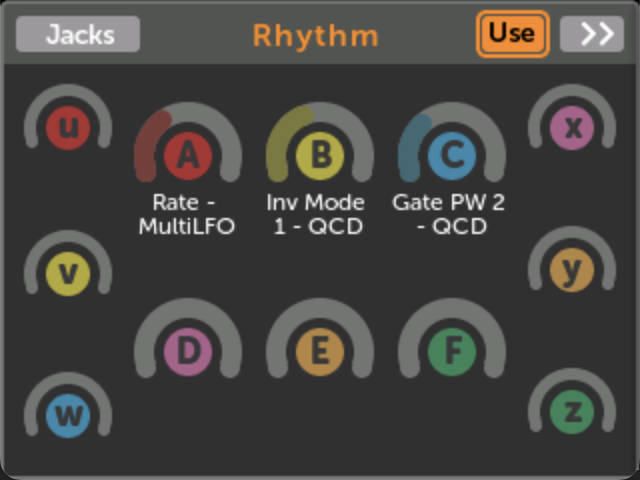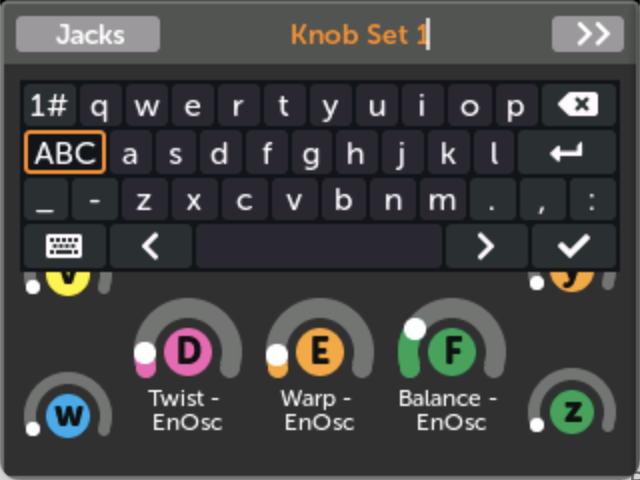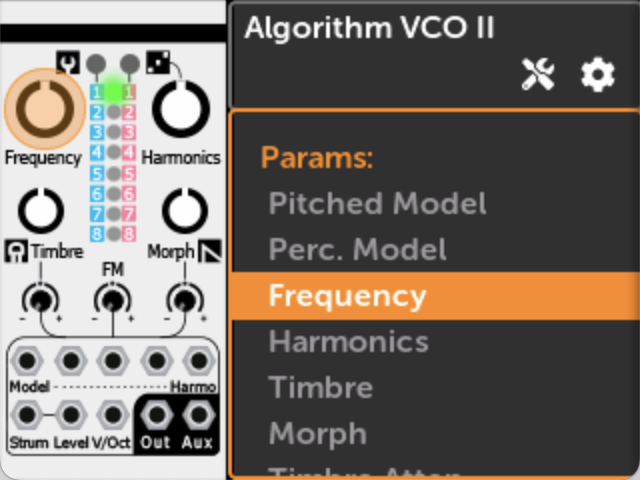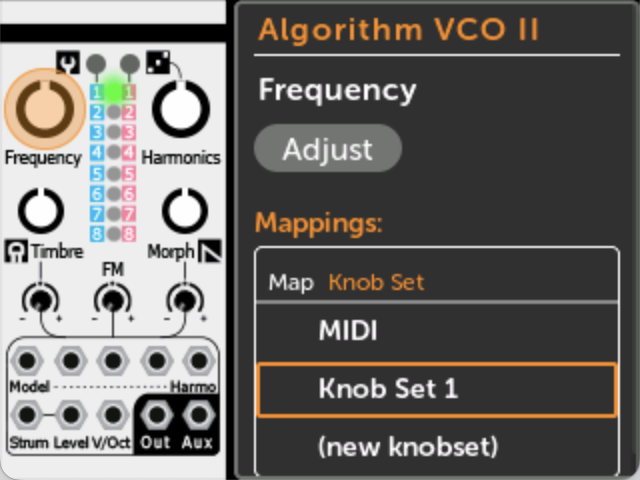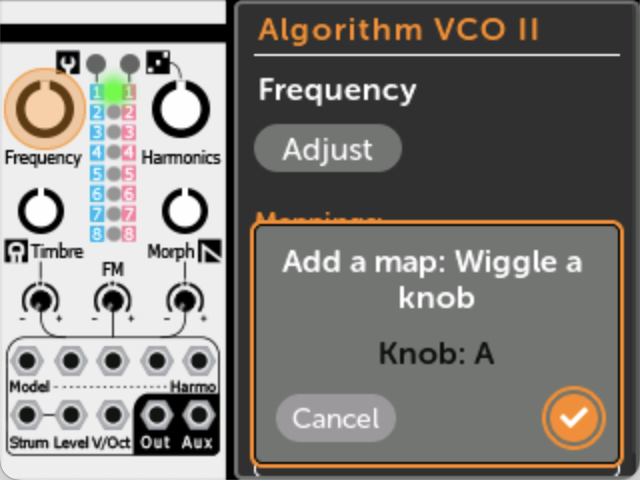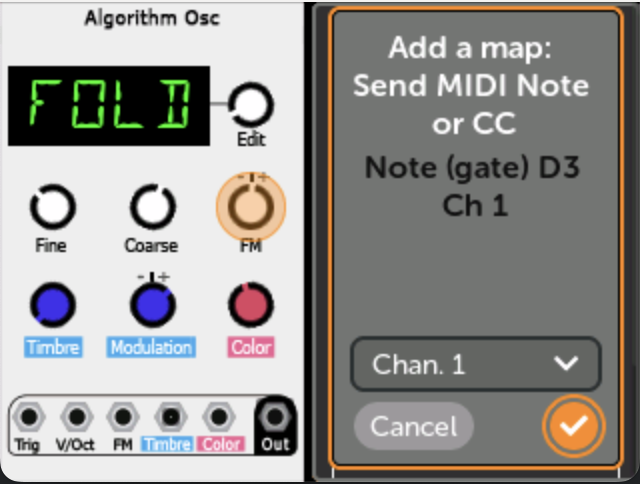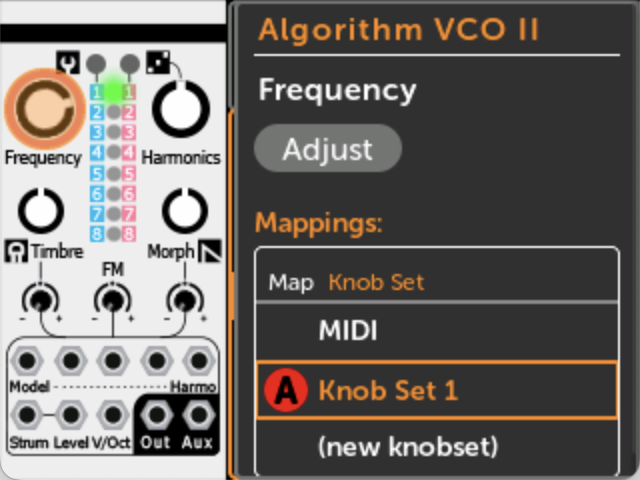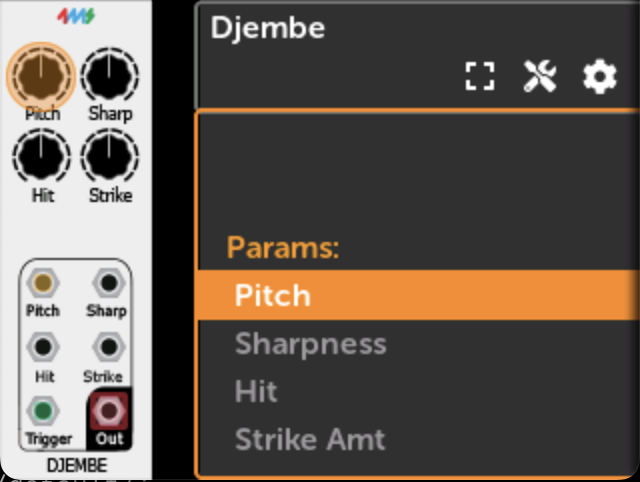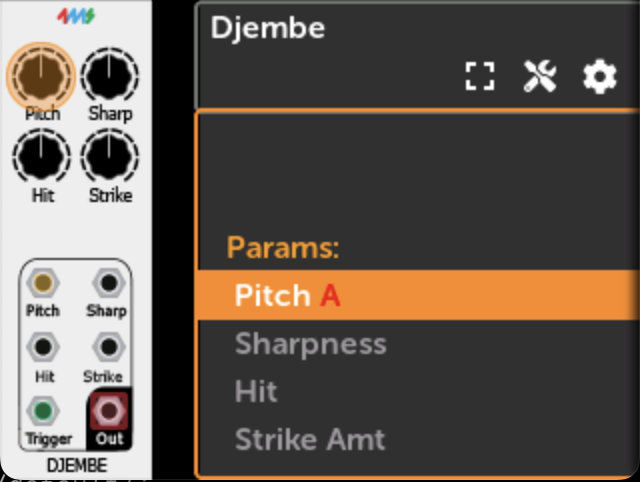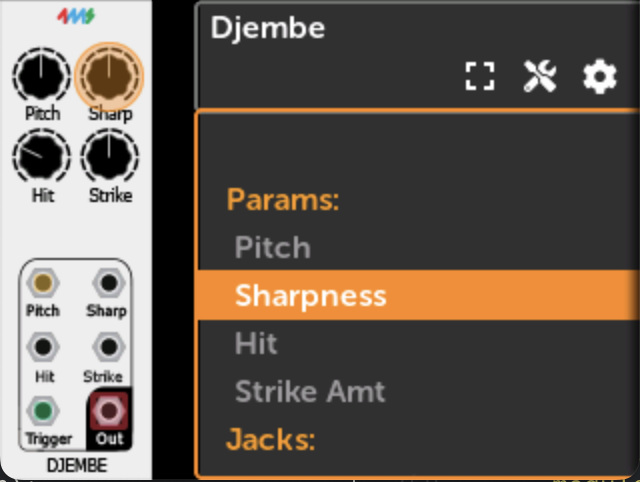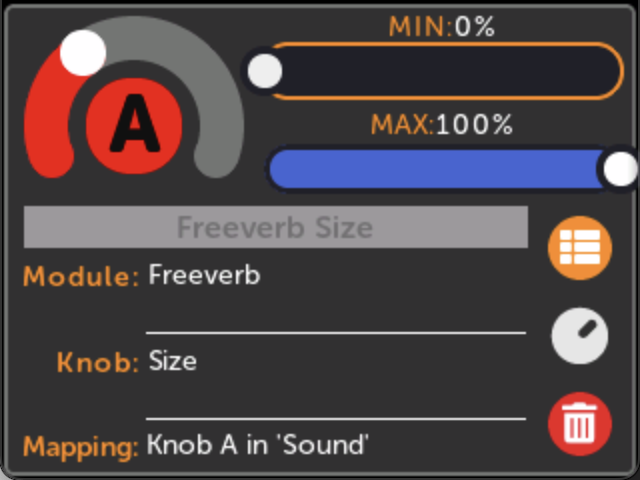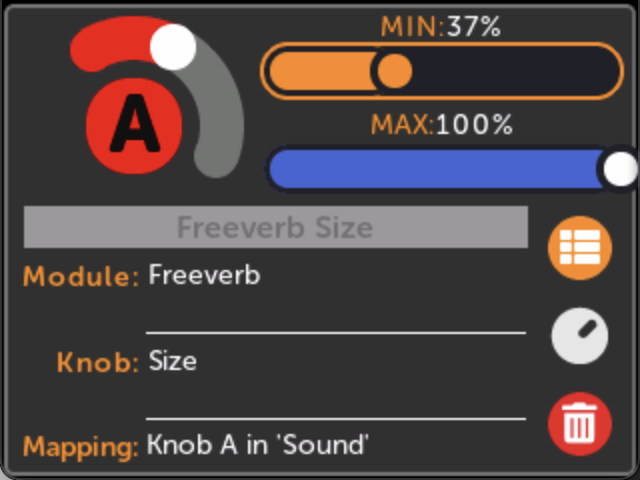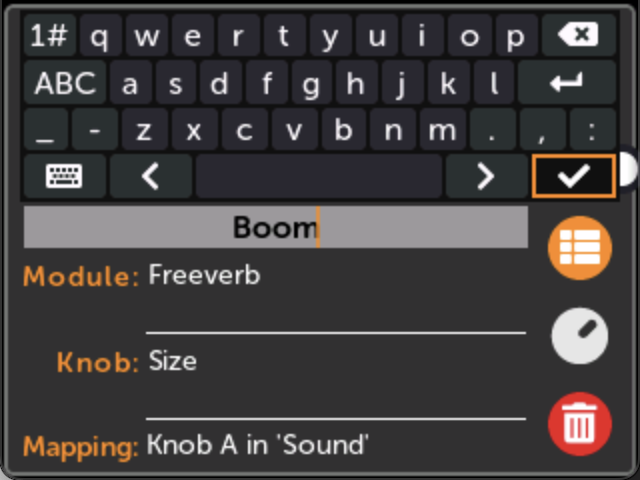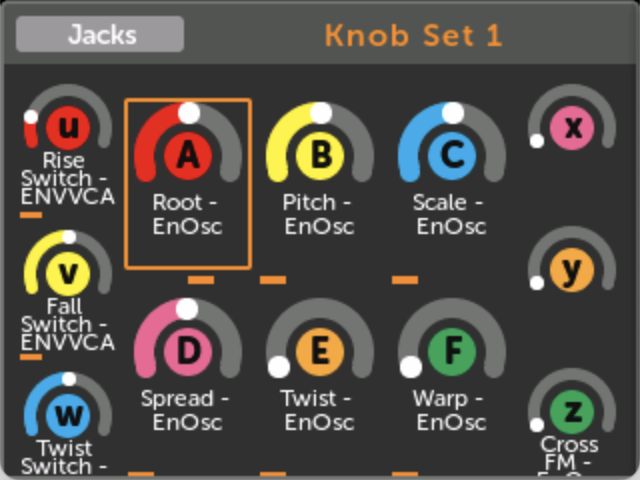Using the MetaModule: Knobs
How to View Knob and Jack Mappings
-
2. Knob mappings are shown
This is a "Knob Set" (see below).
Turn some physical knobs and watch the knobs on the screen turn (the patch must be playing).
Click
Jacksto view jack mappings.
Knob Sets
-
A Knob Set is a group of knob mappings. Each Knob Set maps the 12 physical knobs to virtual module controls. For example, a patch might have a Knob Set for each module. Or there might be a Knob Set for controlling various timbre parameters, another Knob Set for controlling rhythmic elements, and another for overall mix.
-
A patch can have up to eight Knob Sets, but only one Knob Set can be active at a time.
-
A single physical knob can be mapped to up to 8 virtual knobs in a Knob Set. See Multi-maps
How to Use a Different Knob Set
From the Knob Set page:
-
1. Click
>>to view the next Knob SetIf there is only one Knob Set in the patch, the >> button will not appear.
-
2. Click
Useto activate a Knob SetNow the physical knobs will control the parameters mapped in the new Knob Set.
Knob Set Shortcut
A fast way to change Knob Sets is to hold down the Back button and turn the encoder.
A pop-up will tell you the name of the Knob Set that was just made active.
The Back button's color will always indicate the Knob Set number:
3
4
5
6
7
8
See more shortcuts on the Shortcuts page.
Creating a new Knob Set
You can create a new knob set in several ways:
-
With VCV Rack, when you make the patch. See Creating Knob Sets in VCV Rack
-
By clicking
(new knobset)when you're creating a new knob mapping (see next section) -
By selecting
Auto-map knobs (new Knob Set)from the module Action menu.
Changing a Knob Set name
From the Knob Set page:
Creating a new Knob Mapping or MIDI Mapping
From the Patch View page:
-
2. Click on a Knob Set that doesn't already have a mapping
If you want to create a new Knob Set, click
(new knobset)If you want to map a MIDI CC or Note to this knob, click
MIDI
-
3. Wiggle the knob you want to map to
If you're mapping MIDI, then send a MIDI Note or CC message. You may select a MIDI Channel if you wish.
If you're mapping to a button on the MetaButtons expander, then press the button.
-
4. Click OK. It's mapped!
If you want to adjust the minimum and maximum values of the mapping, or give the mapping a name, see Edit a Knob Mapping.
Quick Map Shortcut
You can quickly map params by pressing and holding the rotary encoder while wiggling a knob (or pressing a button on the MetaButtons expander). This is a fast way to map a lot of parameters.
-
2. Press and hold the rotary while wiggling a knob
Release the rotary when you see the knob name appear.
The knob will be instantly mapped.
You can remove the mapping by holding down the rotary and tapping the Back button.
Note that the mapping will be created in the currently active Knob Set, and will replace any existing non-MIDI mapping. Use the Knob Set Shortcut in conjunction with this shortcut if you want to create mappings in multiple knob sets.
If you want to quickly map MIDI events to parameters, see Shortcuts
Remove a mapping shortcut
You can quickly remove all mappings to a parameter in the current Knob Set.
-
1. Scroll to the parameter with the mapping you want to remove
Press and hold the rotary, and then tap the Back button. Release the rotary.
See more shortcuts on the Shortcuts page.
Editing a Knob Mapping
From the Knob Set page:
-
3. Click on MIN or MAX to change the range
When the physical knob is all the way down, the virtual knob will be set to the MIN value. Likewise, when the physical knob is all the way up, the virtual knob will be at the MAX value.
If you set MAX to be less than the MIN, the virtual knob will turn the opposite direction as the physical knob.
-
4. Click on the knob name to type an alias
An alias is a name you pick for a knob mapping. If this is a multi-map, then the alias will apply to all mappings within the multi-map.
Mapping to more than one knob (Multi-maps)
A single physical knob can be mapped to up to eight virtual knobs. This is known as a "multi-map". As you turn the physical knob, all the mapped virtual knobs will turn. Each virtual knob can have different minimum and maximum values. In this way, multi-maps allow the MetaModule to act like a macro controller.
For example, if a reverb module has separate wet and dry level knobs, you could map a physical knob to both of these. Then you could set the MIN and MAX values such that as you turn the physical knob up, the dry level will go down, and the wet level will go up, creating a crossfade between the dry and wet signals.
Another example is using multi-maps in a polyphonic patch. One physical knob can control the pitch knobs of all the voices; another physical knob can control the waveshape knobs; another can control the envelope shapes, etc...
Multi-maps exist within a Knob Set. So each Knob Set can have its own set of maps and multi-maps. Since there are a maximum of eight Knob Sets, and each Knob Set has twelve knob multi-maps, and each multi-map can have up to eight virtual knobs, a maximum of 768 virtual knobs can be mapped in a single MetaModule patch.
How to create a multi-map
Multi-maps are created automatically if you create new knob map with a physical knob that's already mapped (in the current knob set). See Creating a New Knob Mapping.
How to view a multi-map
Viewing any module that has a mapping that's a part of a multi-map will display that mapping normally.
If you want to see all the virtual knobs that map to a specific physical knob:
